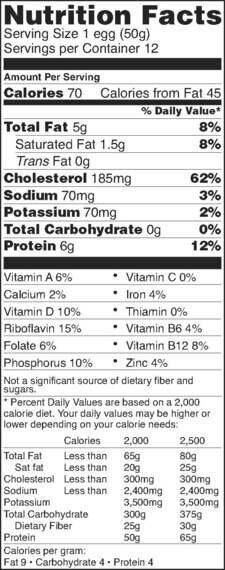
If you buy fertile eggs from a local farm stand and they have not been pre-washed or previously stored in a refrigerator, then it should be fine to store these types of eggs at room temperature. According to Mother Earth News, the best way to stash fresh, unwashed, non-supermarket eggs that have never been refrigerated is in a sealed container at a temperature of 35 to 40 degrees Fahrenheit. The whites may become somewhat runny looking over a period of time, but even after several months--these eggs stay "almost fresh." This is not the case with store-bought supermarket eggs. Supermarket eggs purchased in the U.S. must be refrigerated.
While I was writing my book Beyond The Mediterranean Diet and living as an expat in Switzerland, I was puzzled as to why supermarket eggs in Europe, the U.K. and other parts of the world are sold unrefrigerated. Yet in the U.S. it is a U.S.D.A. (United States Department of Agriculture) law that all eggs be transported, stored and sold under refrigeration.
So what's the scoop? Why are eggs stored at room temperature in the U.K. and Europe? And why do small local farmers in the U.S. follow this same practice?
First let's understand the egg. An egg has a semipermeable membrane containing thousands of pores. When a hen lays an egg, a natural protective coating is deposited on the shell. This is called a bloom or a cuticle. The bloom seals the pores on the shell, making it impervious to bacteria and reducing the loss of moisture. When moisture is lost, carbon dioxide is lost, which results in a clear and runny egg white. On the contrary, a cloudy egg white means the egg is fresh.
Large-scale, factory farmed eggs in the U.S. run a high risk of being contaminated with feces because hygiene is not adequately monitored. In the late 1980s, Salmonella Enteritidis (SE), an egg-borne bacteria found on the outside or inside of the eggshell, emerged and a number of procedures were put into place to prevent the bacteria from spreading.
Vaccinating hens against Salmonella is voluntary in the U.S. According to a New York Times article, it is estimated that one-half to two-thirds of American farmers inoculate their flocks. It is also voluntary to vaccinate in Britain but the majority of egg producers in the U.K. use the well-known quality control "Lion Mark", which requires hens to be vaccinated in accordance with the Lion Quality Code of Practice. As a result, 90% of the egg producers supplying to supermarkets in the U.K. vaccinate their flocks.
Practices of the U.S. egg industry diverge from those of the U.K. and the E.U. because of a mandate by the U.S.D.A., which requires an elaborate method of sanitizing factory eggs. The rigorous washing method strips eggs of its natural, protective coating. This is the reason why U.S. supermarket eggs must be refrigerated. Even if factories spray a food grade coating on the eggs after the washing period ~ only about 10% of supermarket eggs are sprayed ~ eggs still must be kept under refrigeration. Once eggs are refrigerated, they must stay that way. A cold egg left out at room temperature for more than two hours, begins to sweat. This can facilitate the growth of bacteria and increase the risk of food poisoning.
On the other hand, E.U. and U.K. egg marketing laws state that Class A eggs - those found on supermarkets shelves, must not be washed, or cleaned in any way. "In Europe, the understanding is that this mandate actually encourages good husbandry on farms. It's in the farmers' best interests then to produce the cleanest eggs possible, as no one is going to buy their eggs if they're dirty, " explained Mark Williams, Chief Executive, British Egg Industry Council in a phone interview with Forbes.
The bottom line is even if you have a freshly laid egg with the bloom intact, you should not keep it on the counter if it's been refrigerated. It's either in or out, from farm to fork. That's why it's essential to have a conversation with the farmer and find out how the eggs have been handled from farm to your basket.
Egg Trivia
•Yolk color in eggs is directly linked to the diet of the hens.
•Cloudiness of raw white is due to the natural presence of carbon dioxide which has not had time to escape through the shell and is an indication of a very fresh egg. As an egg ages, the carbon dioxide escapes and the egg white becomes more transparent.
•The rupture of a blood vessel on the yolk surface causes a blood spot on an egg yolk during formation of the egg. The eggs are perfectly safe to eat and the spot can be removed with a fork, if you wish.
•Clean and healthy hens produce clean and healthy eggs.
•Avoid eating raw or undercooked eggs or products containing raw or undercooked eggs.
•Follow the Safe Handling Instructions on the carton of eggs.
•The breed of the hen determines the color of her eggs. Nutrient levels are not significantly different in white and brown shell eggs.
•There is no benefit in eating fertilized eggs. There is no nutritional difference in fertilized eggs and infertile eggs. Most eggs sold today are infertile; roosters are not housed with the laying hens. If the eggs are fertile and cell development is detected during the candling process, they are removed from commerce.
For more information on how eggs fit into a healthy diet read my book Beyond The Mediterranean Diet: European Secrets Of The Super-Healthy.

Nutrition Facts ~ One Large Egg